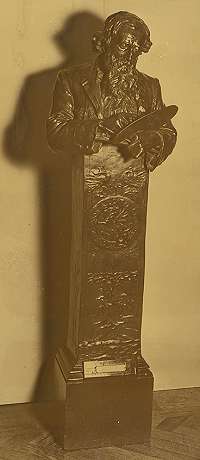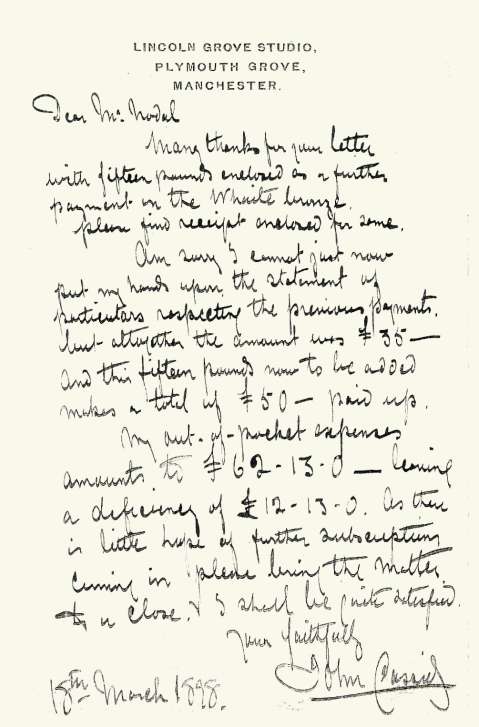
This site celebrates the life and work of sculptor John
Cassidy (1860 - 1939).

Henry Clarence Whaite was one of the founders of, and president of, both the Royal Cambrian Academy and the Manchester Academy of Fine Arts. He was born in Bridge Street, Manchester, in 1828 and attended Manchester Grammar School, where he received the greater part of his education. He became a student at the Manchester School of Design (which became the Manchester School of Art), where he remained for some years before moving to London. Here, he attended Leigh's school in Newman Street, and also studied at the art school at Somerset House and at the Royal Academy Schools.
A visit to Switzerland with his Manchester teacher James Astbury Hammersley (headmaster of the Manchester School of Design from 1849 to 1862) at the beginning of the 1850s, where the grandeur of the Alps awoke in him the love of mountain scenery which became so characteristic of his work. This led Whaite to Wales in 1851, and eventually to make his home in the Conwy valley, where he stayed for the rest of his life.
In 1859 he exhibited at the Royal Academy in London, where it is said that the artist and critic John Ruskin criticised his overly minute execution, causing him to adopt a bolder style, clearly influenced, like his mentor Hammersley, by Turner. One critic quoted by Susan Thompson wrote: 'His reach often exceeded his grasp, therefore his art was not always perfect. But his failures were better than many men's successes.'
He married a local girl, Jane Alice Griffith, in 1876, and they had one daughter, Lily Florence Whaite, who also became an artist.
He died in 1912 and was buried at Llangelynnin New Church in the Conwy valley; this church closed in the 1980s, and, interestingly, later became the studio of sculptor David Chapman, like Whaite and John Cassidy a member of the Royal Cambrian Academy.
Links and references:
Bibliographical and family information from the Catalogue of the Whaite papers at the National Library of Wales, and detailed Whaite family research published on the web by Joy Whaite of New South Wales, Australia, who also kindly supplied us with the picture.
Works by Whaite in public collections on the Your Paintings website.
Whaite prints for sale online Art Prints on Demand
Useful in many ways: The Victorian Web
More detail on Whaite is in the fine book Manchester's Victorian Art scene and its unrecognised artists by Susan W. Thompson (Manchester Art Press, 2007) p.184-187.
All comments welcome: write to us at
charlie@johncassidy.org.uk
Website created and compiled by Charlie Hulme and Lis Nicholson, with the invaluable assistance of the John Cassidy Committee, Slane Historical Society.
Henry Clarence Whaite (1828 - 1912) - he normally used the forename Clarence - was a painter, mostly of landscapes in watercolour. A bronze bust of him, created by Cassidy, is in the collection of the Manchester City Art Gallery, as are a number of his (rather fine, in this writer's opinion) paintings, images of two of which, Snow in Harvest and Just Arrived by the Sloop, Conway Valley, North Wales can be viewed on the Gallery website.
The bust is currently in store in the Gallery, out of public view, and we have, thanks to the archives at the John Rylands Library, one of a letter written by John Cassidy to John Howard Nodal (1831-1909), editor of the Manchester City News, noted local historian, and Chairman of the Manchester Arts Club, reproduced below.

Dear
Mr
Nodal,
Many thanks for your letter with fifteen pounds enclosed as a further payment on the Whaite bronze. Please find receipt enclosed for same.
Am sorry I cannot just now put my hands upon the statement of particulars respecting the previous payments, but altogether the amount was £35- and this fifteen pounds now to be added makes a total of £50- paid up.
My out-of-pocket expenses amounts to £62.13.0 - leaving a difference of £12.13.0. As there is little hope of further subscriptions coming in please bring the matter to a close. I shall be quite satisfied.
Yours faithfully, John Cassidy. 18th March 1898.
Many thanks for your letter with fifteen pounds enclosed as a further payment on the Whaite bronze. Please find receipt enclosed for same.
Am sorry I cannot just now put my hands upon the statement of particulars respecting the previous payments, but altogether the amount was £35- and this fifteen pounds now to be added makes a total of £50- paid up.
My out-of-pocket expenses amounts to £62.13.0 - leaving a difference of £12.13.0. As there is little hope of further subscriptions coming in please bring the matter to a close. I shall be quite satisfied.
Yours faithfully, John Cassidy. 18th March 1898.
From this, and the Gallery's 1898 accession date for the bust, we can deduce that Nodal headed a committee to commemorate Waite's 70th birthday by the presentation of a bust to the Gallery. The letter tells us a lot about Cassidy's character, as he was happy to donate himself one-fifth of the cost of this tribute to a fellow artist.
To put these sums into perspective, £50 was considered a good annual wage for a manual worker at that time. Even a schoolteacher might expect a similar sum as an 'assistant master.' Cassidy would, of course; have had to pay a foundry to cast the final bronze bust from his model.
Henry Clarence Whaite was one of a whole family of artists (all descended from John Whaite, a Manchester shoemaker.) Henry Clarence's uncle, Thomas Whaite, designed the banner for the 1819 'Peterloo' petition (see our Dialect Writers' Memorial page), his uncle James was painter who also worked in the Conwy Valley, and his father Henry ran an well-known art gallery and art materials shop in Bridge Street, Manchester.
A later artist, also called H. Clarence Whaite (1895-1978), a distant cousin of his namesake, created many wood-engravings and paintings. He also has one work in the City Art Gallery, and a considerable collection in the Whitworth Gallery of The University of Manchester; he also wrote books on mediaeval art and customs.
The image of Cassidy's letter, from the John Howard Nodal Archive, was provided by The John Rylands University Library, The image is included by kind permission of The John Rylands University Library's Heritage Imaging team, e-mail uml.chicc@manchester.ac.uk, and must not be reproduced without permission.
As an unpublished letter, the copyright of the text resides with the estate of John Cassidy. We have made considerable efforts to contact the copyright holder: if anyone has information about who this might be, we would be very pleased to hear from them.
Written by Charlie Hulme, February 2008. Updated August 2014.